Numerical Investigations for Rock-Breaking Process and Cutter Layout Optimization of a PDC Drill Bit with Dual-Cutter
Abstract
1. Introduction
2. Model Description
- (1)
- The wear and deformation of the bit are not taken into consideration since its strength and hardness surpass that of rock. Therefore, the bit is treated as a rigid body during modeling.
- (2)
- The influence of failed rock elements is disregarded, whereby element failure refers to their removal from the system.
- (3)
- The pressure exerted by liquids on rocks remains constant, while any impact caused by fluid jets on rocks is not accounted for.
- (4)
- The effects of rock reaction forces located far from the cutting area are not considered in this study.
2.1. Governing Equations
2.1.1. Explicit Dynamics Calculation for Finite Elements
2.1.2. Contact Mode of Drilling Bit and Rock
2.1.3. Rock Constitutive Model and Failure Criterion
2.1.4. Cohesive Elements with Damage
2.1.5. Evaluation Model of Breaking Efficiency
2.2. Geometry Model
2.3. Simulation Conditions
2.4. Model Verification
3. Results and Discussions
3.1. Mechanism Analysis of Rock Breaking by Dual-Cutters
3.2. Influence of Horizontal and Vertical Offset Distance between Two Cutters
3.3. Layout Optimization for the Dual-Cutters
3.3.1. Relationships between the Offset and MSE Based on Response Surface Methodology
3.3.2. Cutter Layout Optimization through Gray Wolf Algorithm
3.3.3. Comparison in Field Tests
3.4. Advantages of the Dual-Cutter Cutting
4. Conclusions
- (1)
- By comparing the results of the simulated and actual Brazilian disk tests, it turns out that the modeling method of global insertion of zero-thickness cohesive elements between solid elements can simulate rock failure nicely. According to the test results, the forms of rock crack initiation and expansion in the simulated experiment are consistent with the actual results, and the error of the obtained rock stress–strain curve is also minor (less than ) with the actual results. In general, the accuracy of this modeling approach is sufficient for applications in the field of fracture, and it can be applied to simulate fracture processes.
- (2)
- During the cutting of dual-cutters, the rock-breaking process of the front cutter is similar to that of the single-cutter, which forms a brittle failure area on the surface, and a plastic failure area is formed at a certain distance from the surface. However, when the back cutter cuts, the groove formed by the front cutter changes the stress state of the rock surface, and the rock near the groove also produces residual plastic strain. The two work together, and when the back cutter cuts along the spine in the middle of the two grooves, there will be a significant crack through the surface, forming large pieces of rock debris, while the brittle damaged area is more extensive. This cutting mode can considerably reduce the cutting force and energy consumption of the cut, improving the energy utilization of the rock-breaking process and its efficiency.
- (3)
- In the numerical simulation of the influence of different vertical and horizontal offset coefficients of the cutter after the study, the shift of the vertical offset coefficient has a minor influence on the combined specific work of rock breaking. The MSE changes significantly with the vertical offset coefficient only when the horizontal offset coefficient is , and the minimum value is obtained when the vertical offset coefficient is . The horizontal offset coefficient has an apparent effect on the MSE. The joint-specific work is unchanged when the vertical coefficient is constant and the horizontal offset coefficient is from to . However, when the horizontal offset coefficient is from to , the combined specific work decreases significantly, from 50–65 MPa to 50–60 MPa.
- (4)
- The response surface method has been employed to bond the offset coefficients and MSE. Additionally, the Gray Wolf algorithm was applied to optimize the offsets to obtain a minimum MSE. The optimal combination of offset coefficients: for vertical and for horizontal.
Author Contributions
Funding
Data Availability Statement
Conflicts of Interest
References
- Qiu, T.; Feng, J.; Cai, B.; Fan, G.; Zhang, W.; Liu, Y. Microstructural Evolution of Diamond-Based Composites at High Temperature and High Pressure. Materials 2022, 15, 8753. [Google Scholar] [CrossRef] [PubMed]
- Zuo, R.Q. International advancement of drilling bits for oil and gas well (4)-PDC bits progress and present trend (I). Explor. Eng. (Rock Soil Drill. Tunneling) 2016, 43, 40–48. [Google Scholar]
- Peng, N.; Ma, T.; Zhu, G.; Su, Q. Anti-drilling ability of Ziliujing conglomerate formation in Western Sichuan Basin of China. Petroleum 2023, 9, 41–52. [Google Scholar] [CrossRef]
- Dougherty, P.S.M.; Pudjoprawoto, R.; Fred Higgs, C. Bit cutter-on-rock tribometry: Analyzing friction and rate-of-penetration for deep well drilling substrates. Tribol. Int. 2014, 77, 178–185. [Google Scholar] [CrossRef]
- Negm, S.; Aguib, K.; Karuppiah, V.; ElOufy, M.; Remah, M.; Zayyan, M.; Sheikh, O.E. The Disruptive Concept of 3D Cutters and Hybrid Bits in Polycrystalline Diamond Compact Drill-bit Design. In Proceedings of the SPE Abu Dhabi International Petroleum Exhibition and Conference, Abu Dhabi, United Arab Emirates, 7–10 November 2016; SPE-183335-MS. pp. 1–10. [Google Scholar]
- Hsieh, L.; Endress, A. Better and better, bit by bit/New drill bits utilize cutting structures, cutter element shapes, advanced modeling to increase ROP, control, durability. Drill. Contract. 2015, 71, 48–60. [Google Scholar]
- Yahiaoui, M.; Gerbaud, L.; Paris, J.Y.; Denape, J.; Dourfaye, A. A study on PDC drill bits quality. Wear 2013, 298–299, 32–41. [Google Scholar] [CrossRef]
- Perneder, L.; Detournay, E.; Downton, G. Bit/rock interface laws in directional drilling. Int. J. Rock Mech. Min. Sci. 2012, 51, 81–90. [Google Scholar] [CrossRef]
- Halliburton. New Halliburton Drill Bit Optimizes Cutter Layout for Increased Durability and Drilling Speed. Available online: https://drilling-contractor.org/new-halliburton-drill-bit-optimizes-cutter-layout-increased-durability-drilling-speed-46374 (accessed on 20 August 2023).
- Pryhorovska, T.O.; Chaplinskiy, S.S.; Kudriavtsev, I.O. Finite element modelling of rock mass cutting by cutters for PDC drill bits. Pet. Explor. Dev. 2015, 42, 888–892. [Google Scholar] [CrossRef]
- Zhang, Z.; Zhao, D.; Zhao, Y.; Zhou, Y.; Tang, Q.; Han, J. Simulation and experimental study on temperature and stress field of full-sized PDC bits in rock breaking process. J. Pet. Sci. Eng. 2020, 186, 106679. [Google Scholar] [CrossRef]
- Zeuch, D.H.; Finger, J.T. Rock Breakage Mechanisms with a PDC Cutter. In Proceedings of the SPE Annual Technical Conference and Exhibition, Presented at the SPE Annual Technical Conference and Exhibition, Society of Petroleum Engineers, Las Vegas, NV, USA, 22–26 September 1985. [Google Scholar]
- Swenson, D.V.; Wesenberg, D.L.; Jones, A.K. Analytical and Experimental Investigations of Rock Cutting Using PDC Drag Cutters. In Proceedings of the the SPE Annual Technical Conference and Exhibition, San Antonio, TX, USA, 4–7 October 1981. [Google Scholar]
- Zeuch, D.H.; Finger, J.T. Rock Breakage Mechanisms with a PDC Cutter. In Proceedings of the All Days, SPE, Las Vegas, NV, USA, 22 September 1985. SPE-14219-MS. [Google Scholar]
- Rojek, J.; Oñate, E.; Labra, C.; Kargl, H. Discrete element simulation of rock cutting. Int. J. Rock Mech. Min. Sci. 2011, 48, 996–1010. [Google Scholar] [CrossRef]
- Loui, J.P.; Rao Karanam, U.M. Numerical Studies on Chip Formation in Drag-Pick Cutting of Rocks. Geotech. Geol. Eng. 2012, 30, 145–161. [Google Scholar] [CrossRef]
- Jaime, M.C.; Zhou, Y.; Lin, J.-S.; Gamwo, I.K. Finite element modeling of rock cutting and its fragmentation process. Int. J. Rock Mech. Min. Sci. 2015, 80, 137–146. [Google Scholar] [CrossRef]
- Menezes, P.L.; Lovell, M.R.; Avdeev, I.V.; Lin, J.S.; Higgs, C.F. Studies on the formation of discontinuous chips during rock cutting using an explicit finite element model. Int. J. Adv. Manuf. Technol. 2014, 70, 635–648. [Google Scholar] [CrossRef]
- Yang, D.; Li, J.; Wang, L.; Gao, K.; Tang, Y.; Wang, Y. Experimental and theoretical design for decreasing wear in conical picks in rotation-drilling cutting process. Int. J. Adv. Manuf. Technol. 2015, 77, 1571–1579. [Google Scholar] [CrossRef]
- Zhang, X.P.; Ji, P.Q.; Liu, Q.S.; Liu, Q.; Zhang, Q.; Peng, Z.H. Physical and numerical studies of rock fragmentation subject to wedge cutter indentation in the mixed ground. Tunn. Undergr. Space Technol. 2018, 71, 354–365. [Google Scholar] [CrossRef]
- Lundqvist, O.G.S.; Chauhan, M. A Plane-Stress Plasticity Model for Masonry for the Explicit Finite Element Time Integration Scheme. RakMek 2020, 53, 240–258. [Google Scholar] [CrossRef]
- Zhao, J.; Xiao, M.; Chen, J.; Li, D. Explicit Dynamic DDA Method Considering Dynamic Contact Force. Shock Vib. 2016, 2016, 7431245. [Google Scholar] [CrossRef]
- Yang, Y.; Zhang, C.; Lin, M.; Chen, L. Research on rock-breaking mechanism of cross-cutting PDC bit. J. Pet. Sci. Eng. 2018, 161, 657–666. [Google Scholar] [CrossRef]
- Liu, W.; Qian, X.; Li, T.; Zhou, Y.; Zhu, X. Investigation of the tool-rock interaction using Drucker-Prager failure criterion. J. Pet. Sci. Eng. 2019, 173, 269–278. [Google Scholar] [CrossRef]
- Wang, W.; Liu, G.; Li, J.; Zha, C.; Lian, W. Numerical simulation study on rock-breaking process and mechanism of compound impact drilling. Energy Rep. 2021, 7, 3137–3148. [Google Scholar] [CrossRef]
- Yao, Y. Linear Elastic and Cohesive Fracture Analysis to Model Hydraulic Fracture in Brittle and Ductile Rocks. Rock Mech. Rock Eng. 2012, 45, 375–387. [Google Scholar] [CrossRef]
- Wang, H. Numerical modeling of non-planar hydraulic fracture propagation in brittle and ductile rocks using XFEM with cohesive zone method. J. Pet. Sci. Eng. 2015, 135, 127–140. [Google Scholar] [CrossRef]
- Zhou, W.; Tang, L.; Liu, X.; Ma, G.; Chen, M. Mesoscopic simulation of the dynamic tensile behaviour of concrete based on a rate-dependent cohesive model. Int. J. Impact Eng. 2016, 95, 165–175. [Google Scholar] [CrossRef]
- Anemangely, M.; Ramezanzadeh, A.; Behboud, M.M. Geomechanical parameter estimation from mechanical specific energy using artificial intelligence. J. Pet. Sci. Eng. 2019, 175, 407–429. [Google Scholar] [CrossRef]
- Al-Sudani, J.A. Real-time monitoring of mechanical specific energy and bit wear using control engineering systems. J. Pet. Sci. Eng. 2017, 149, 171–182. [Google Scholar] [CrossRef]
- Badrouchi, F.; Rasouli, V.; Badrouchi, N. Impact of hole cleaning and drilling performance on the equivalent circulating density. J. Pet. Sci. Eng. 2022, 211, 110150. [Google Scholar] [CrossRef]
- Najjarpour, M.; Jalalifar, H.; Norouzi-Apourvari, S. Fifty years of experience in rate of penetration management: Managed pressure drilling technology, mechanical specific energy concept, bit management approach and expert systems—A review. J. Pet. Sci. Eng. 2022, 208, 109184. [Google Scholar] [CrossRef]
- Liu, Z.; Wu, W.; Hao, Q.; Sun, P.; Ding, Y. Theoretical and Experimental Study of the Effects of Impact Drilling Parameters on the Properties of Surrounding Rock Damage. Shock Vib. 2020, 2020, 8865619. [Google Scholar] [CrossRef]
- Li, Y.; Zhang, T.; Tian, Z.; Zheng, Y.; Yang, Z. Simulation on compound percussive drilling: Estimation based on multidimensional impact cutting with a single cutter. Energy Rep. 2021, 7, 3833–3843. [Google Scholar] [CrossRef]
- Xie, H.; Li, C.; He, Z.; Li, C.; Lu, Y.; Zhang, R.; Gao, M.; Gao, F. Experimental study on rock mechanical behavior retaining the in situ geological conditions at different depths. Int. J. Rock Mech. Min. Sci. 2021, 138, 104548. [Google Scholar] [CrossRef]
- Shams, G.; Rivard, P.; Moradian, O. Observation of Fracture Process Zone and Produced Fracture Surface Roughness in Granite under Brazilian Splitting Tests. Theor. Appl. Fract. Mech. 2023, 125, 103680. [Google Scholar] [CrossRef]
- Huang, J.; Zeng, B.; He, Y.; Wang, X.; Qian, L.; Xia, C.; Yi, X. Numerical study of rock-breaking mechanism in hard rock with full PDC bit model in compound impact drilling. Energy Rep. 2023, 9, 3896–3909. [Google Scholar] [CrossRef]
- Íñiguez-Macedo, S.; Lostado-Lorza, R.; Escribano-García, R.; Martínez-Calvo, M.Á. Finite Element Model Updating Combined with Multi-Response Optimization for Hyper-Elastic Materials Characterization. Materials 2019, 12, 1019. [Google Scholar] [CrossRef] [PubMed]
- Qin, B.; Qin, W.; Lin, X.; Tang, S. Optimization of stamping process parameters of heat shield based on BBD design and response surface methodology. Autom. Manuf. Ind. 2015, 37, 57–60. [Google Scholar]
- Rodrigues, F.; Pelletier, L.G.; Rocchi, M.; Neiva, H.P.; Teixeira, D.S.; Cid, L.; Silva, L.; Monteiro, D. Trainer-exerciser relationship: The congruency effect on exerciser psychological needs using response surface analysis. Scand. J. Med. Sci. Sport. 2021, 31, 226–241. [Google Scholar] [CrossRef]
- Wang, Q.; Chen, D.; Wang, F.; Gao, X.; Zou, Y.; Tian, Z.; Li, S.; Chang, S.; Yao, D. Origin and distribution of an under-pressured tight sandstone reservoir: The Shaximiao Formation, Central Sichuan Basin. Mar. Pet. Geol. 2021, 132, 105208. [Google Scholar] [CrossRef]
- Peng, W.; Hu, G.; Wang, Y.; Liu, D.; Lv, Y.; Luo, X.; Chen, Z. Geochemical characteristics of light hydrocarbons and their influencing factors in natural gases of the Kuqa Depression, Tarim Basin, NW China. Geol. J. 2018, 2863, 2863–2873. [Google Scholar] [CrossRef]
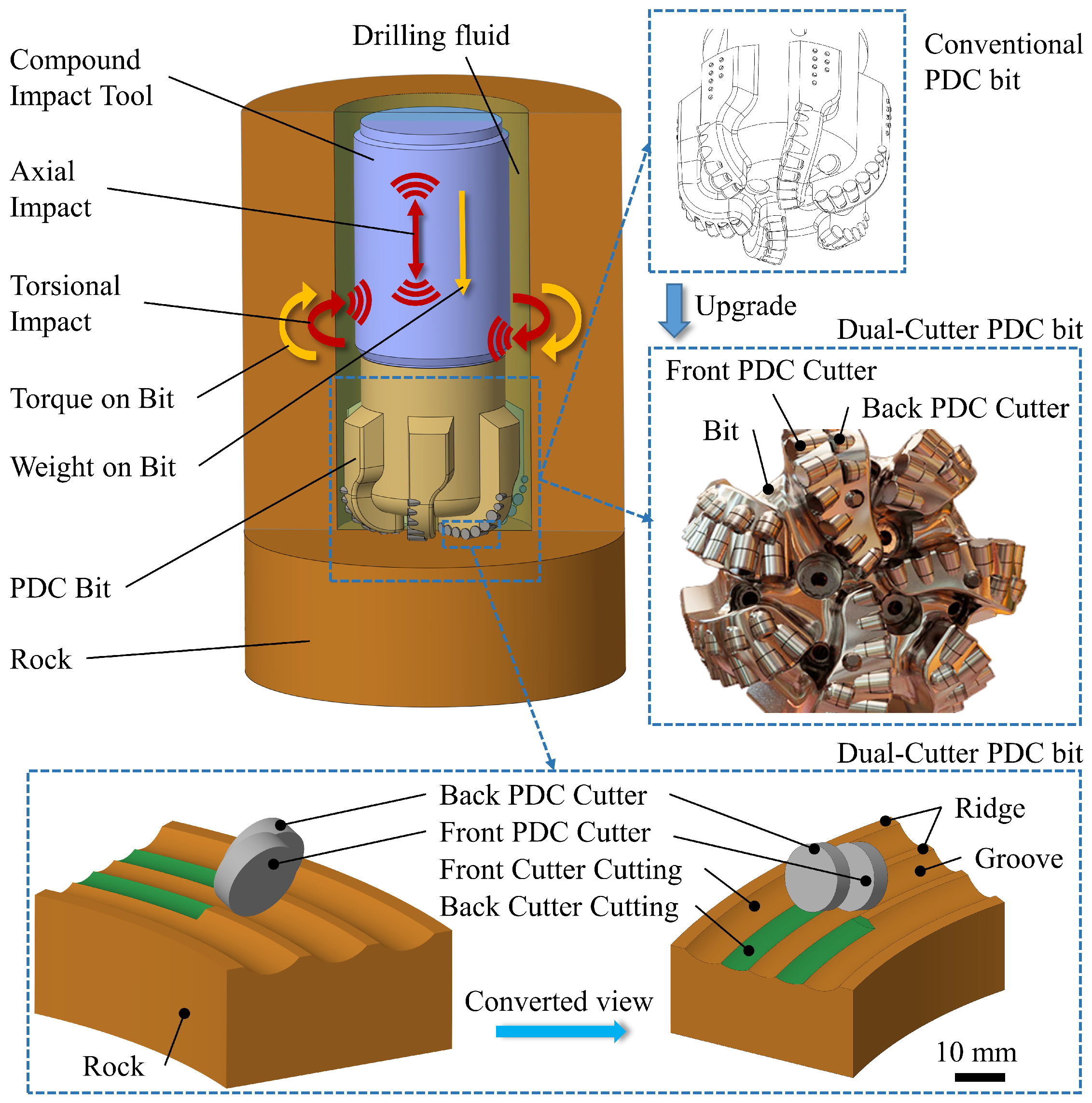
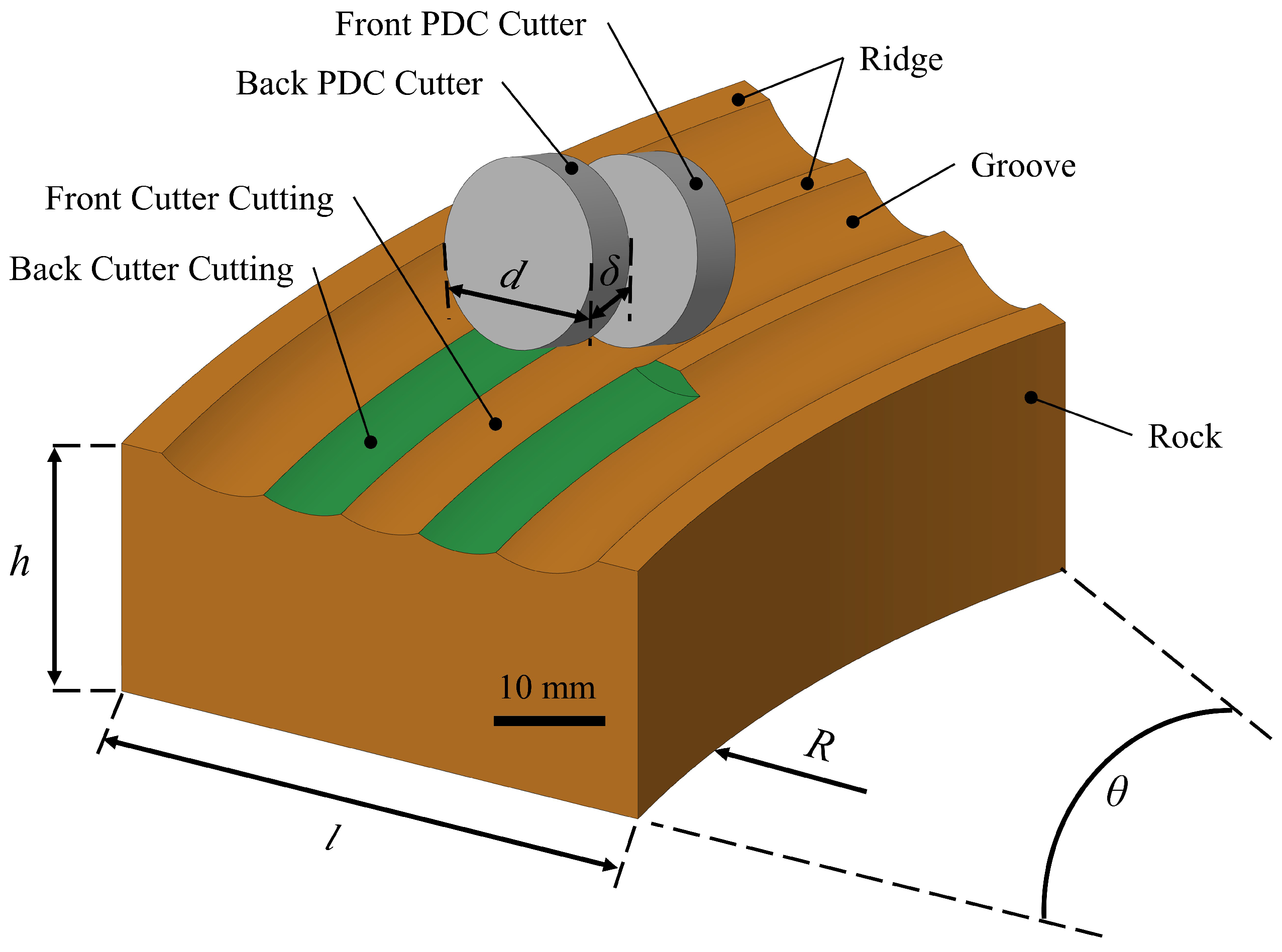

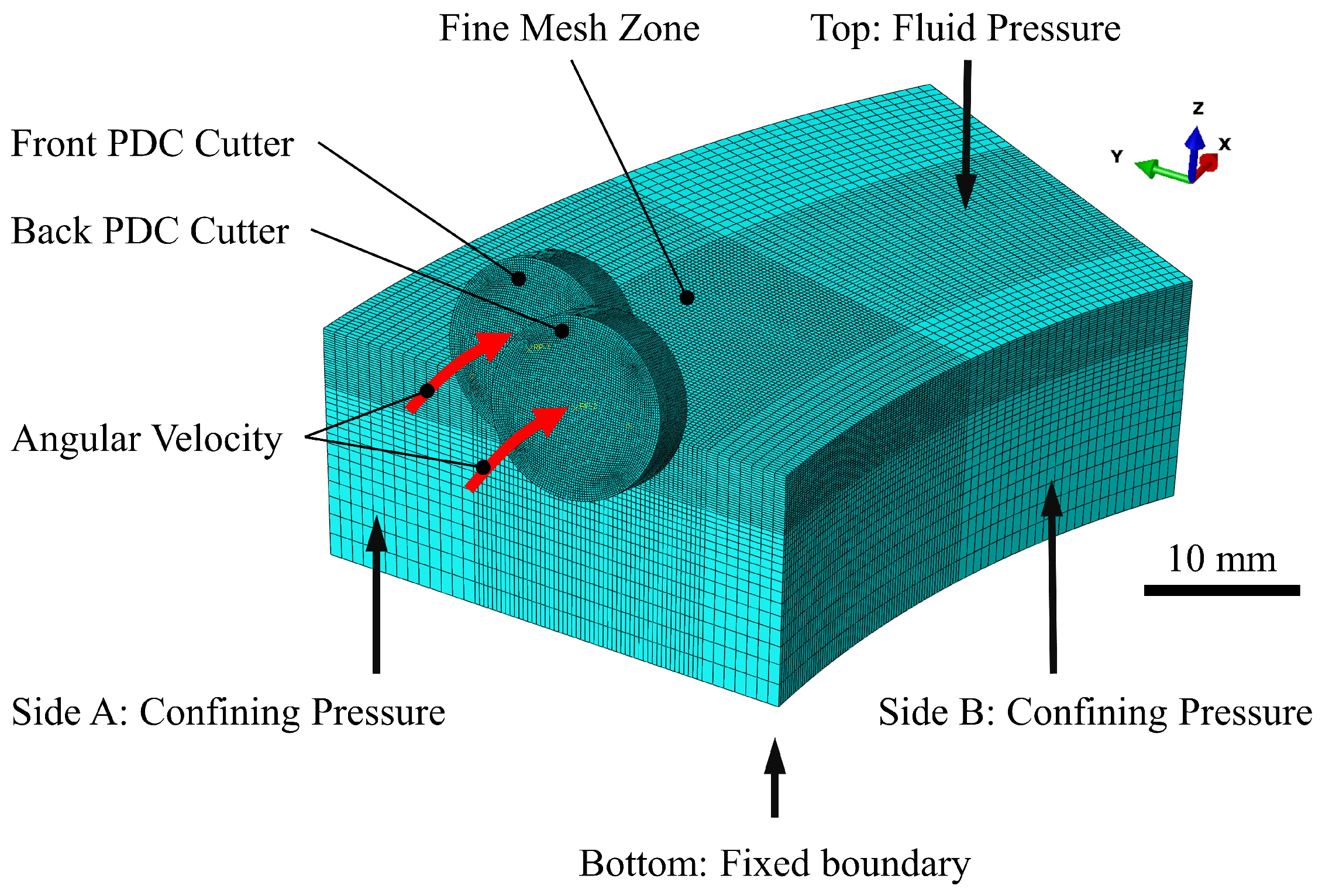
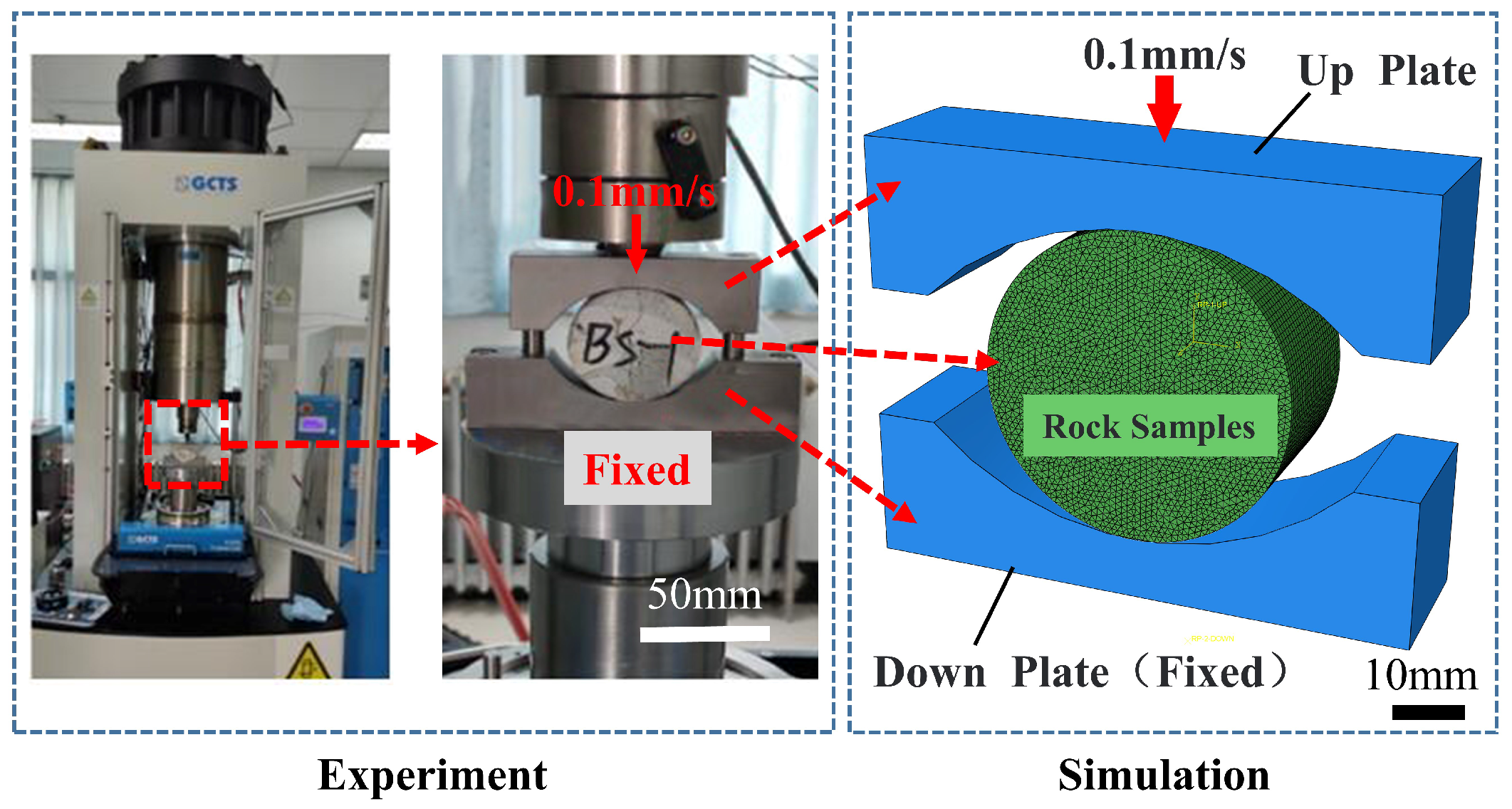
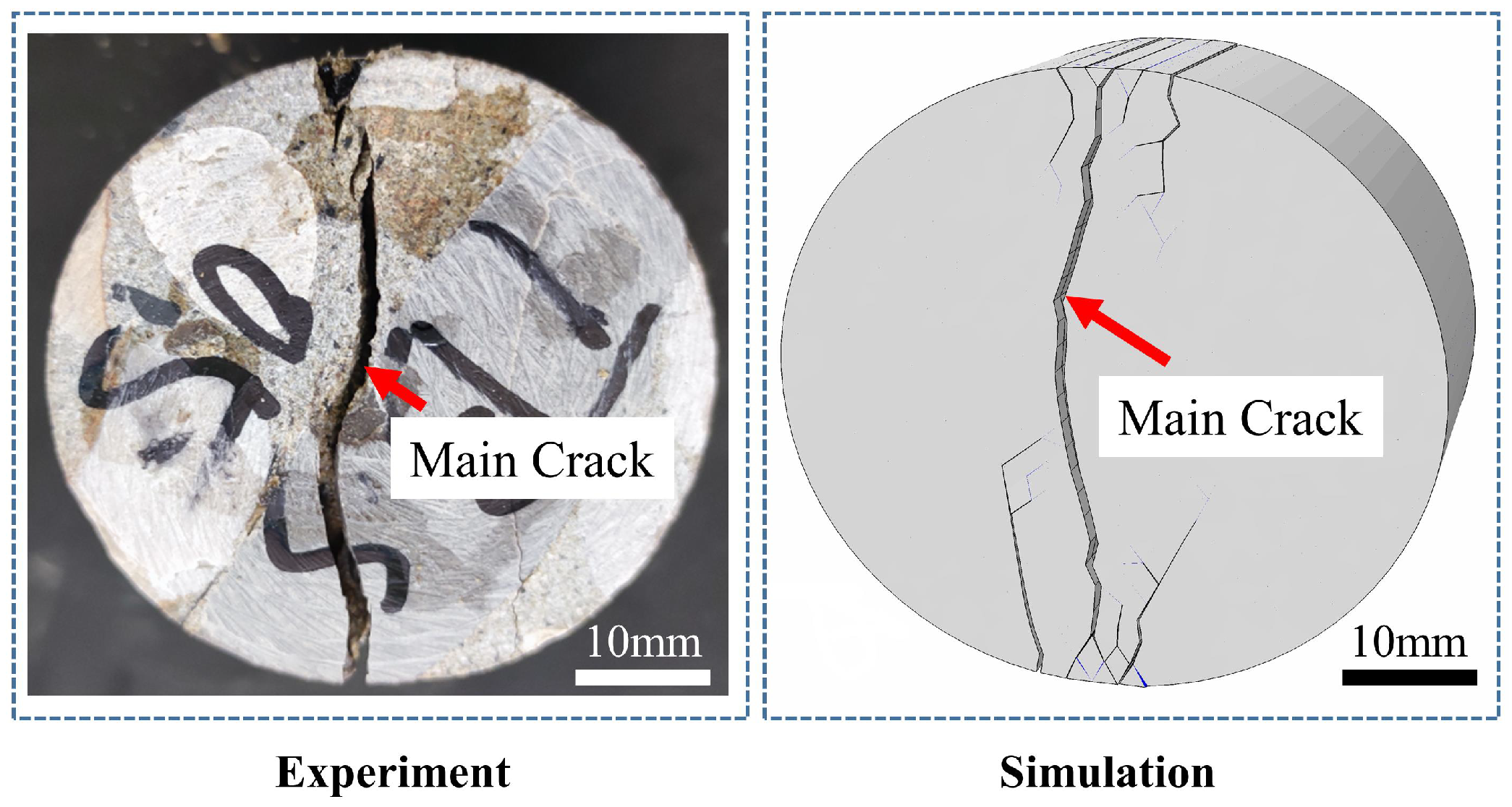
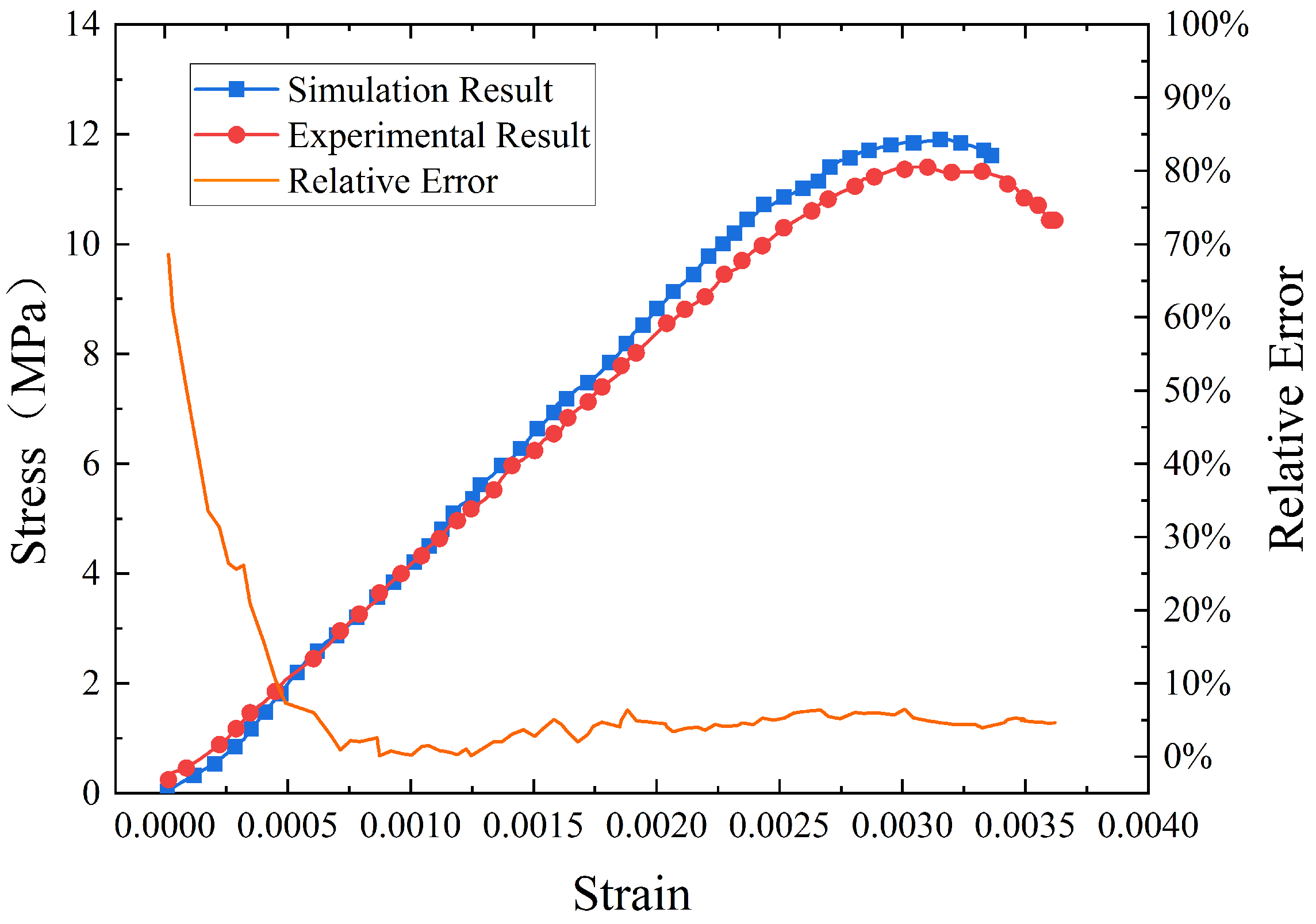

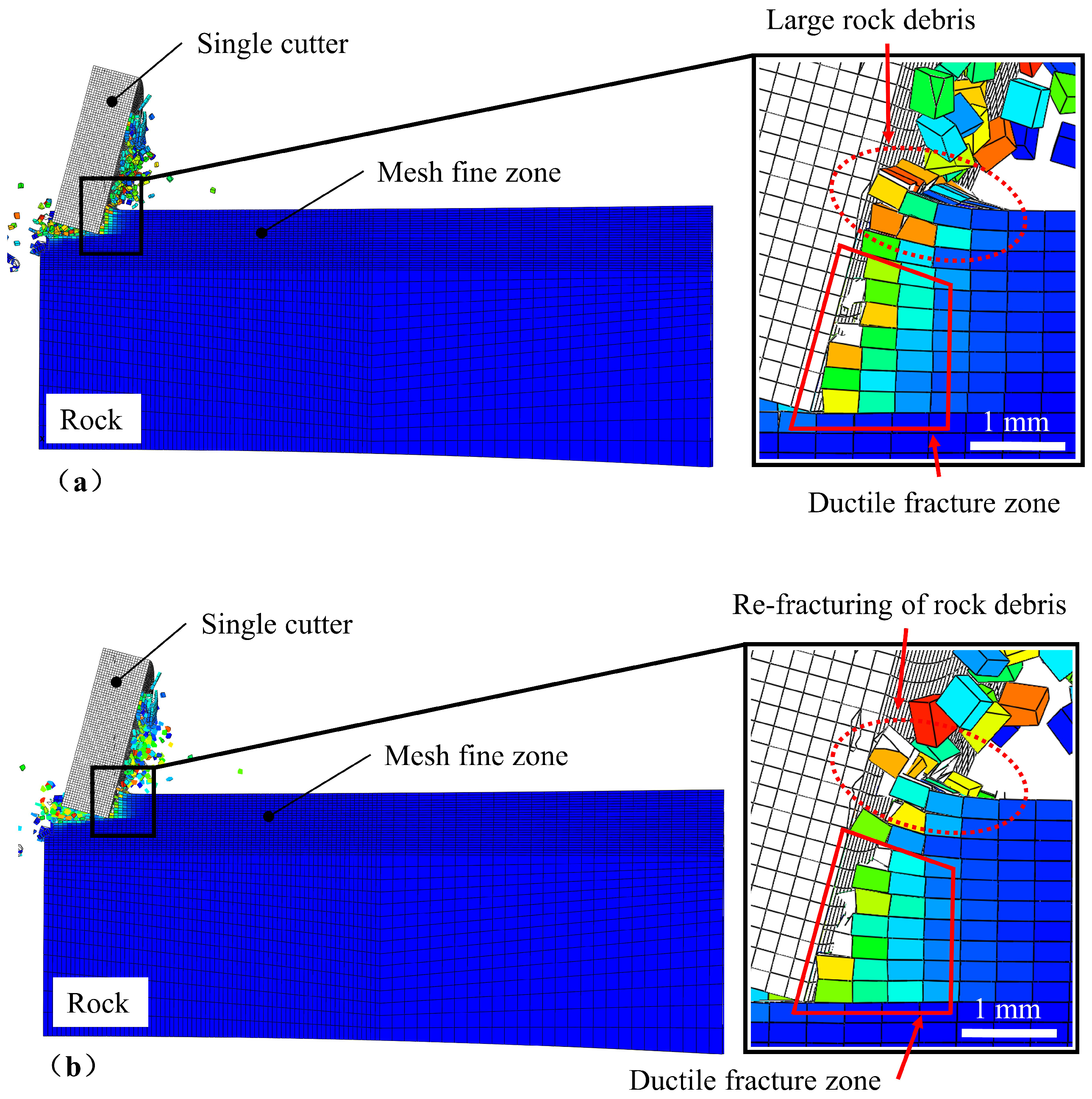
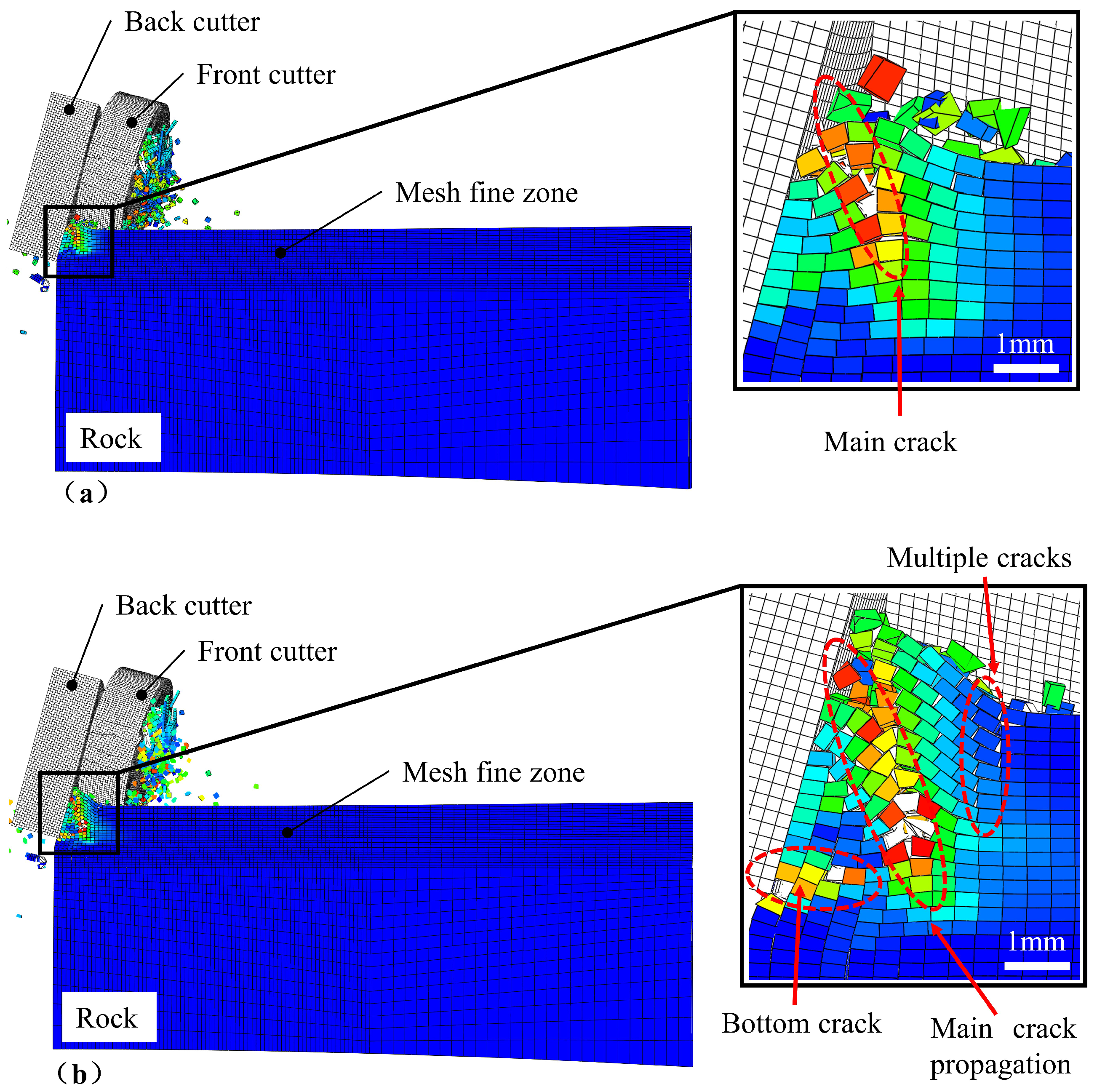
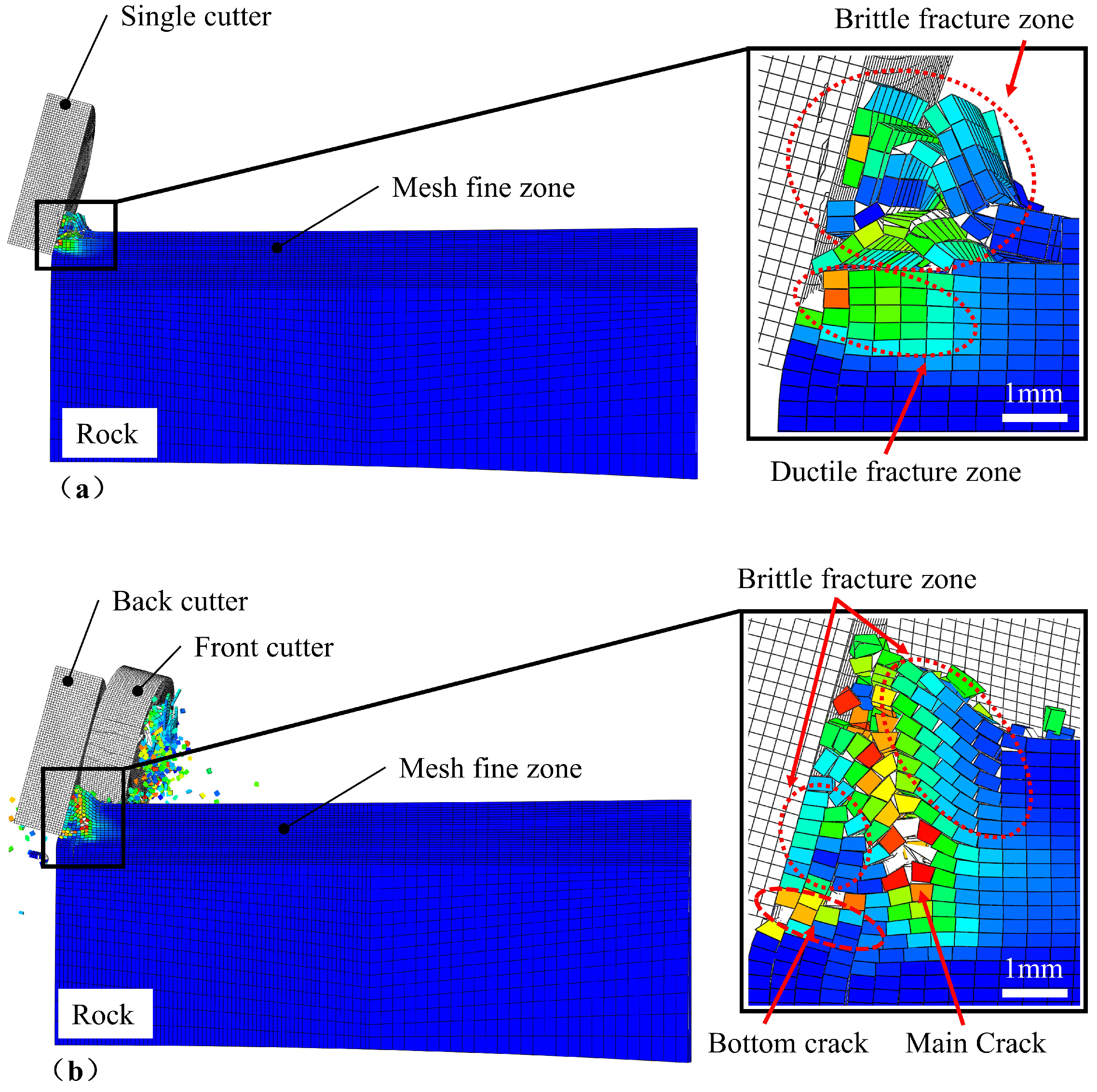
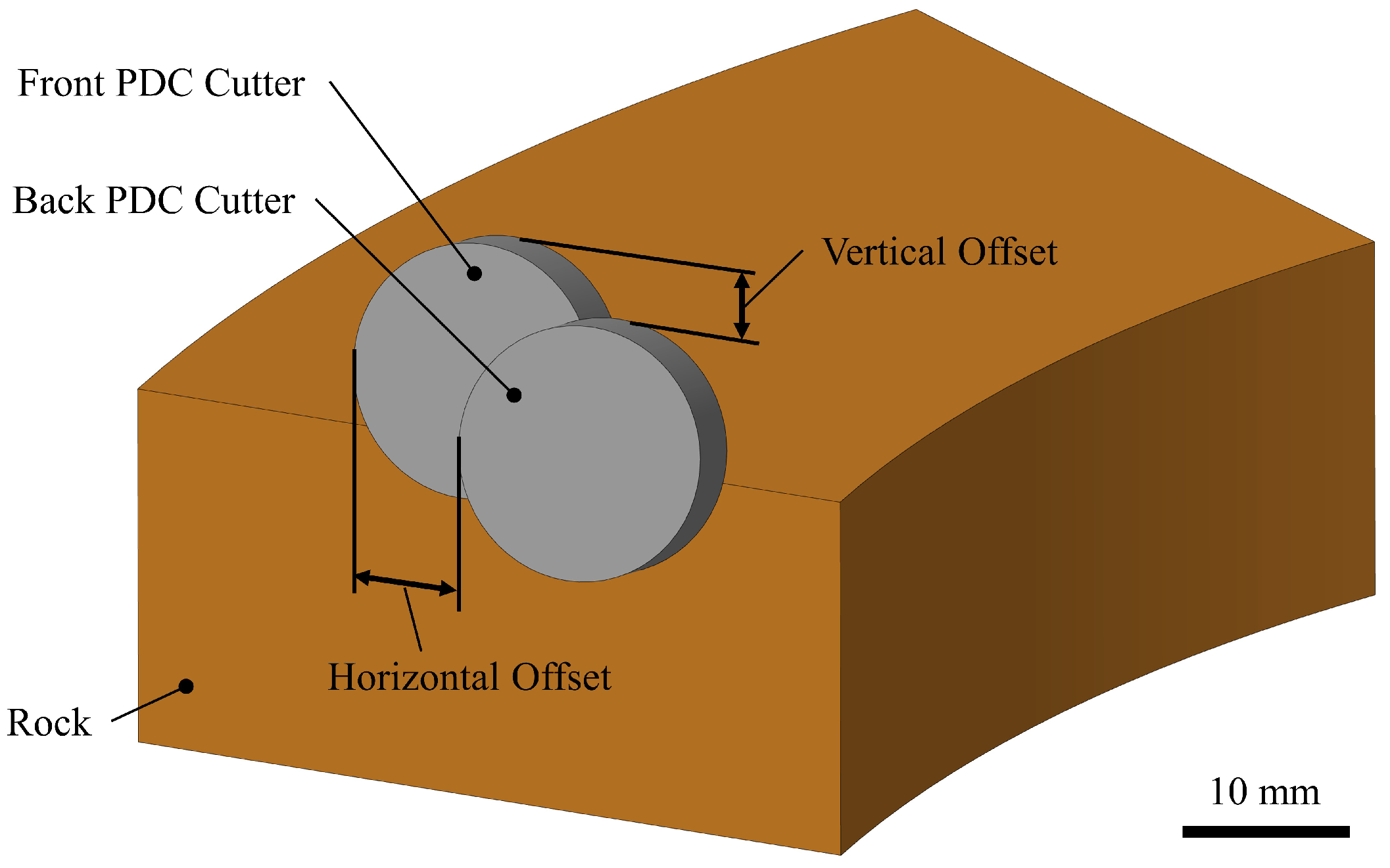
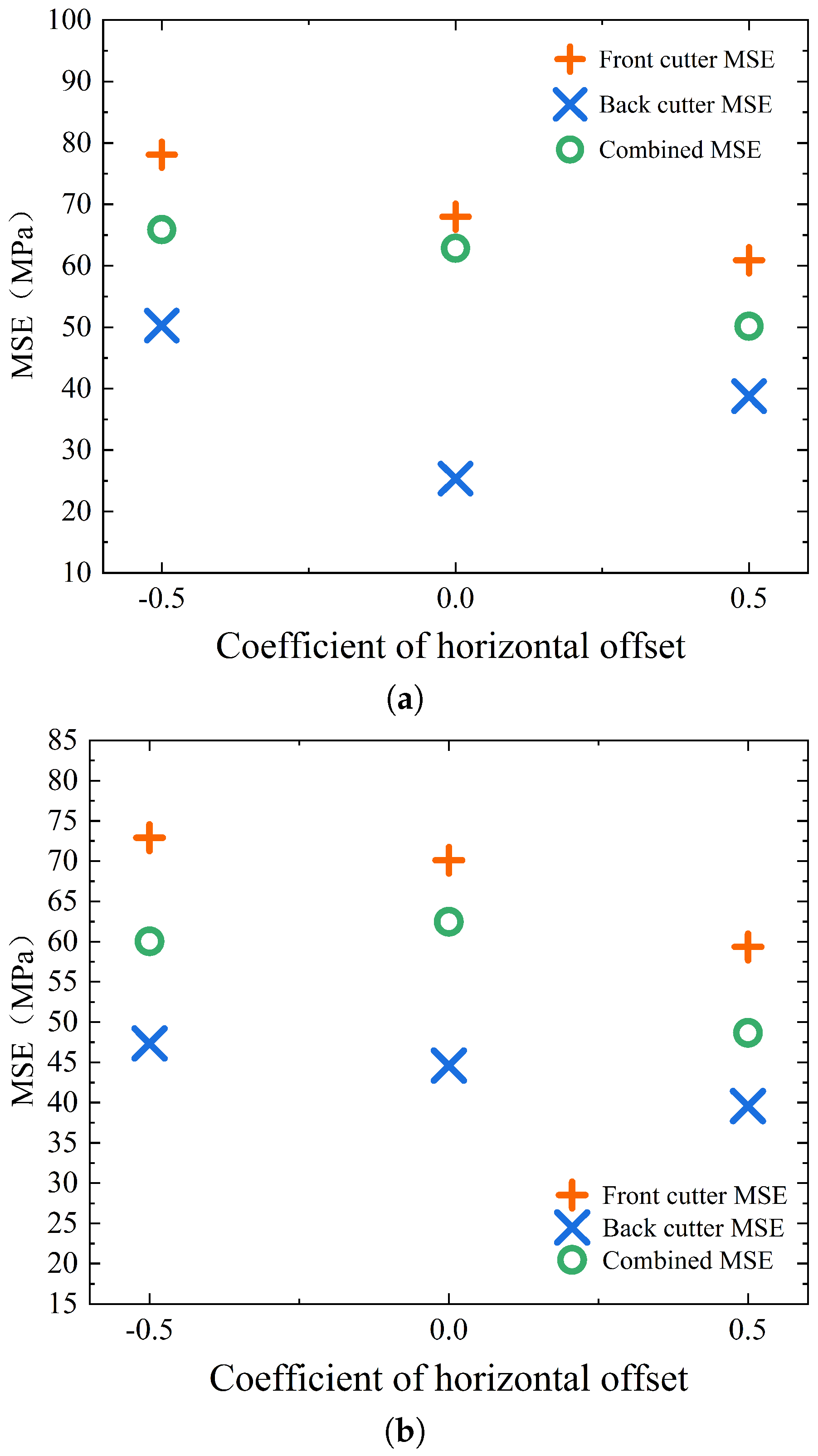
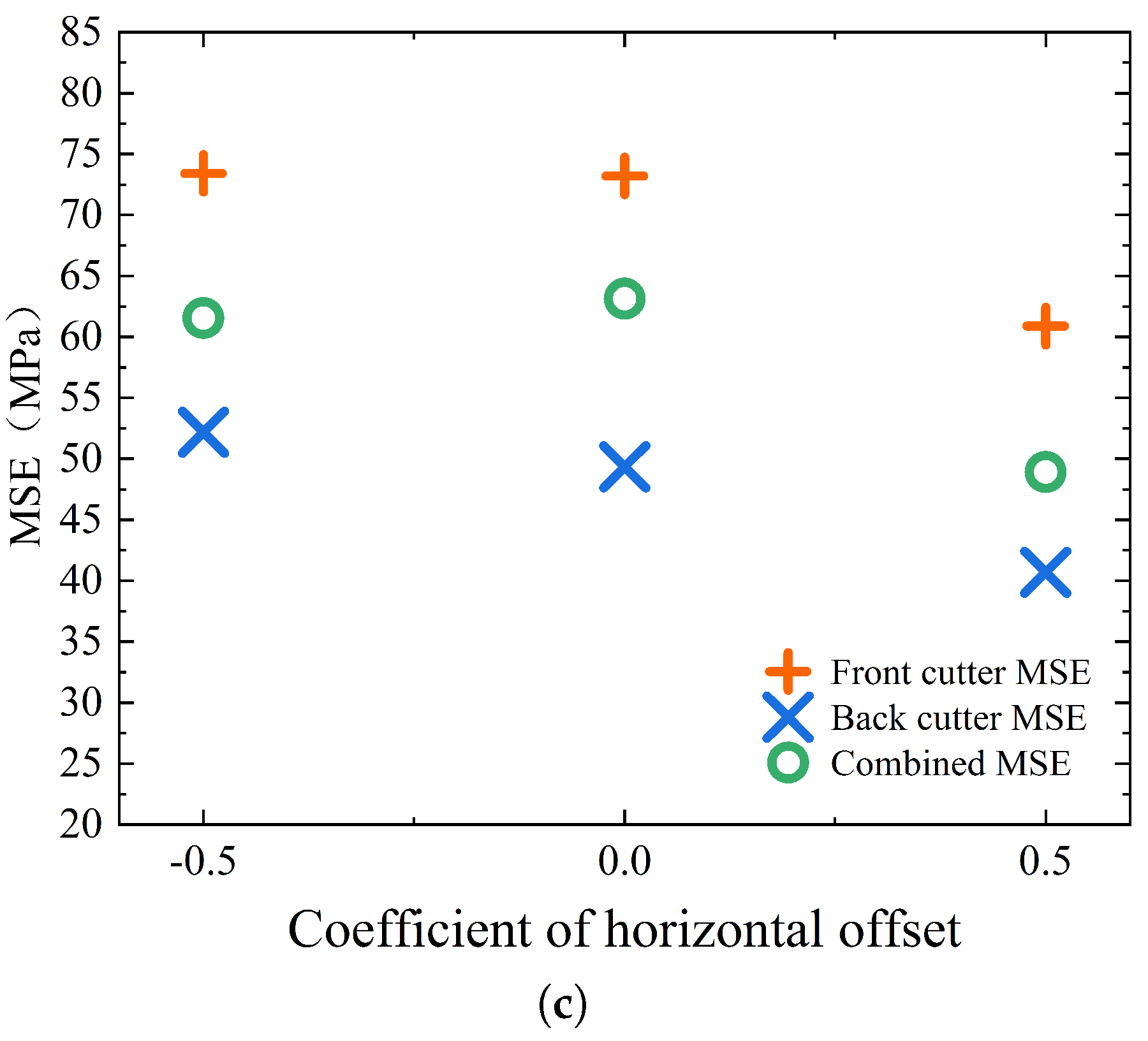
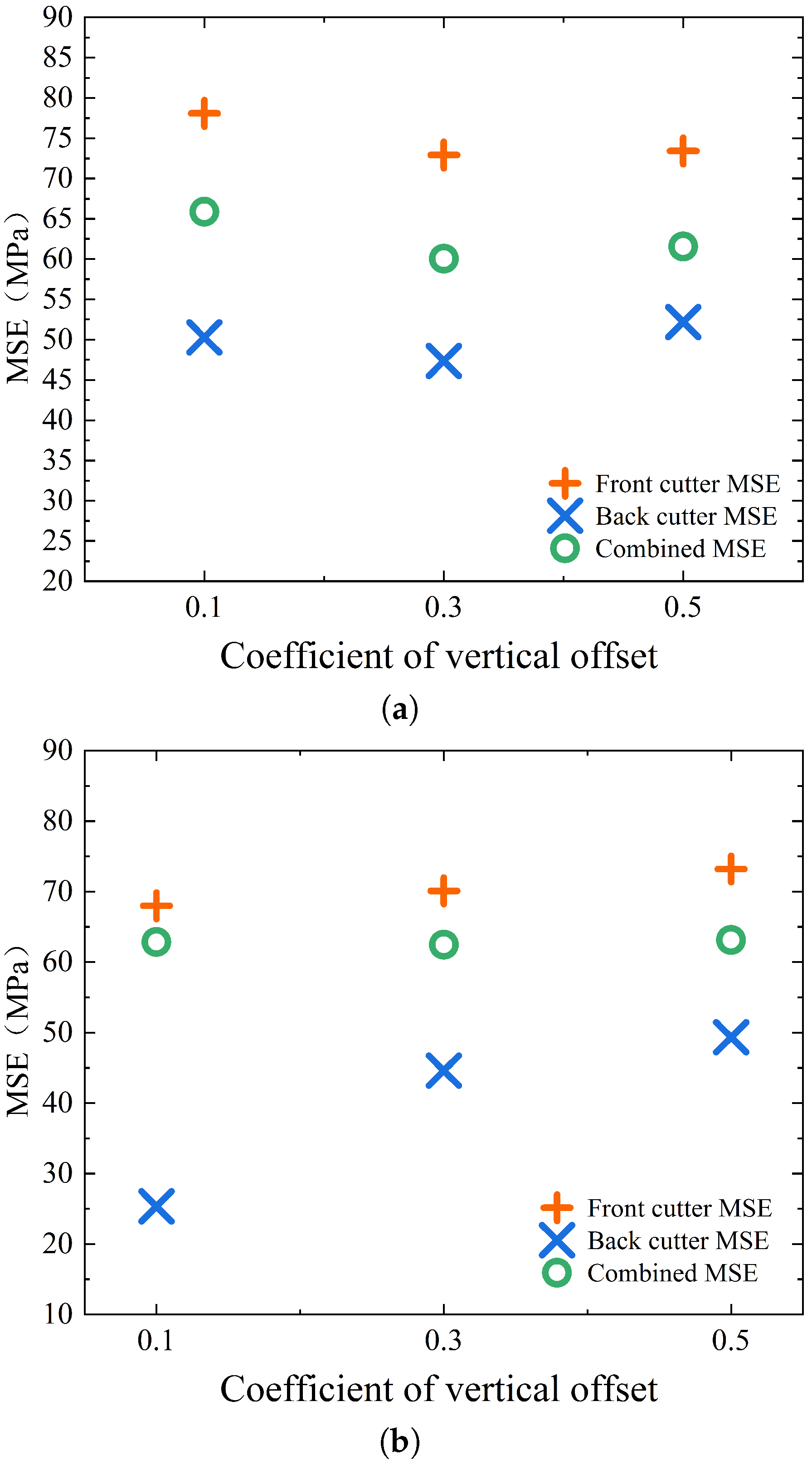
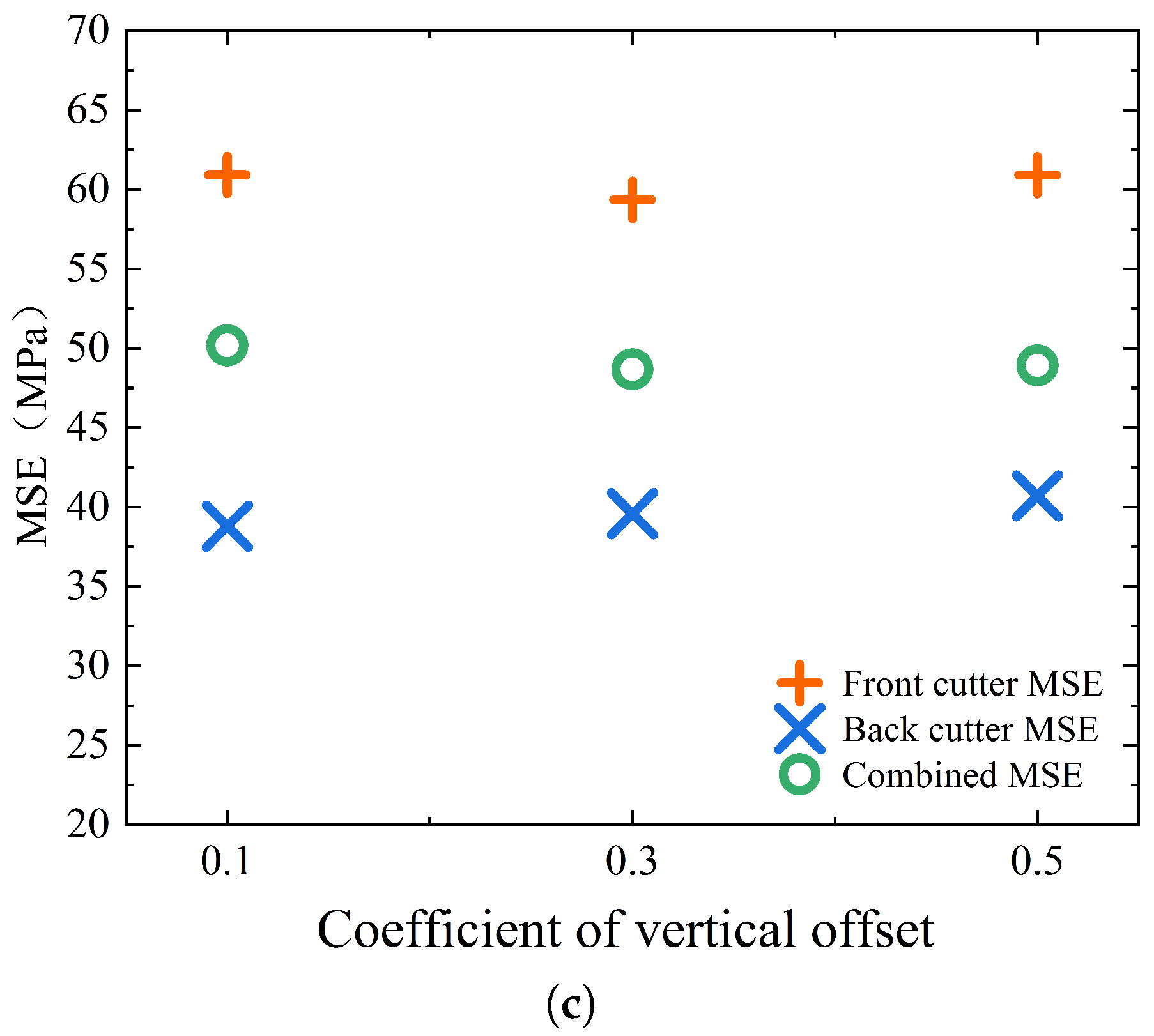
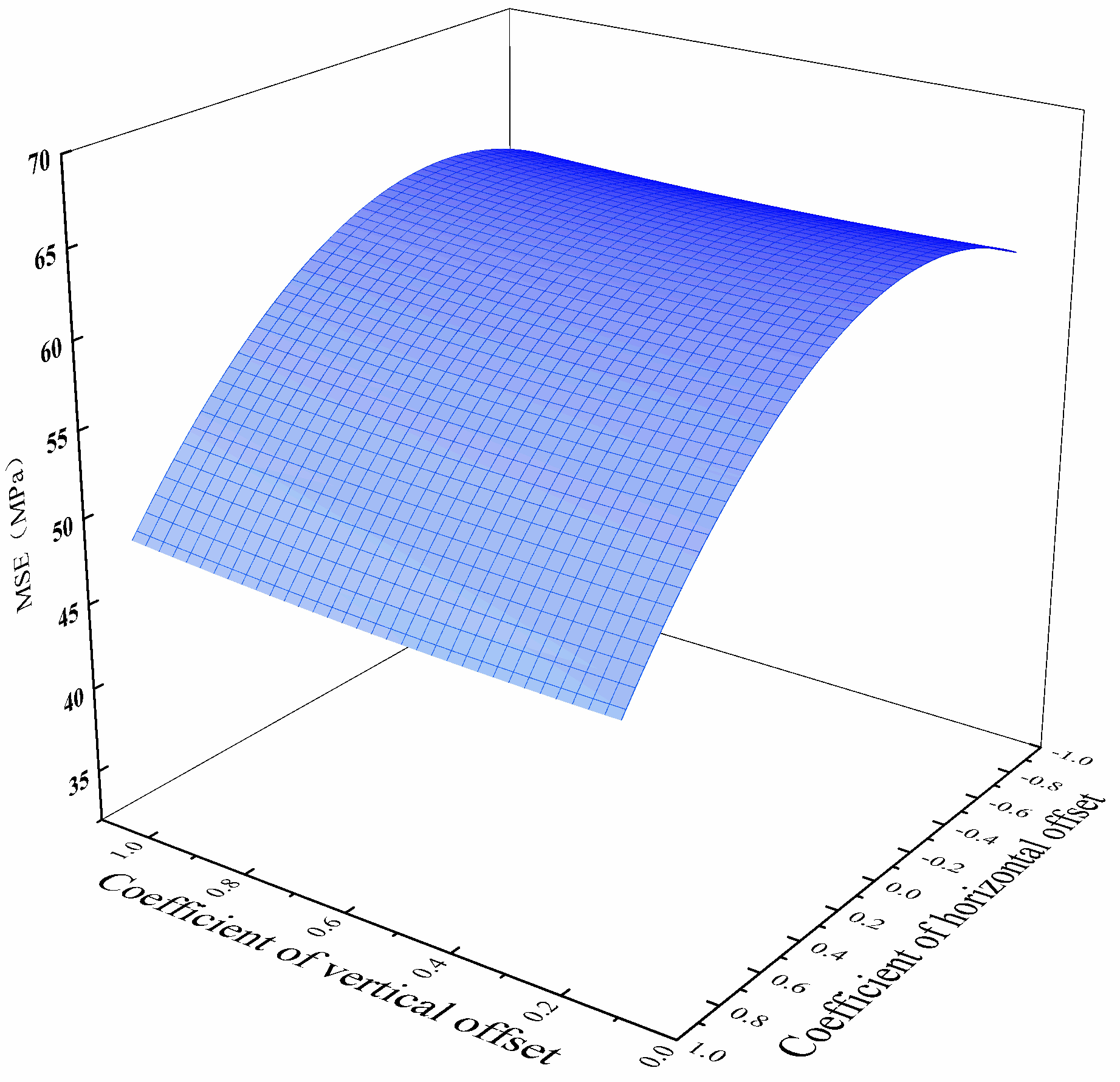

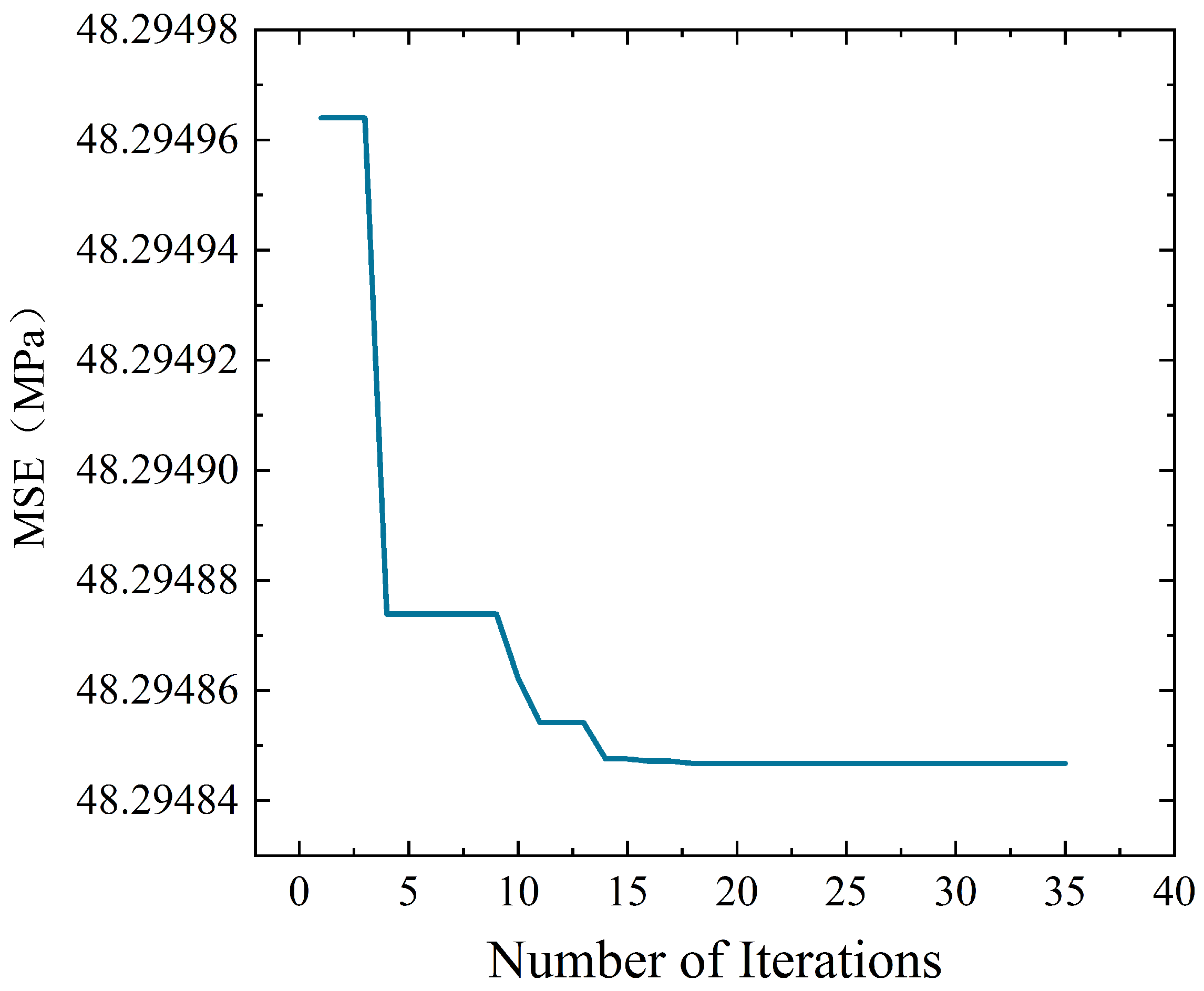
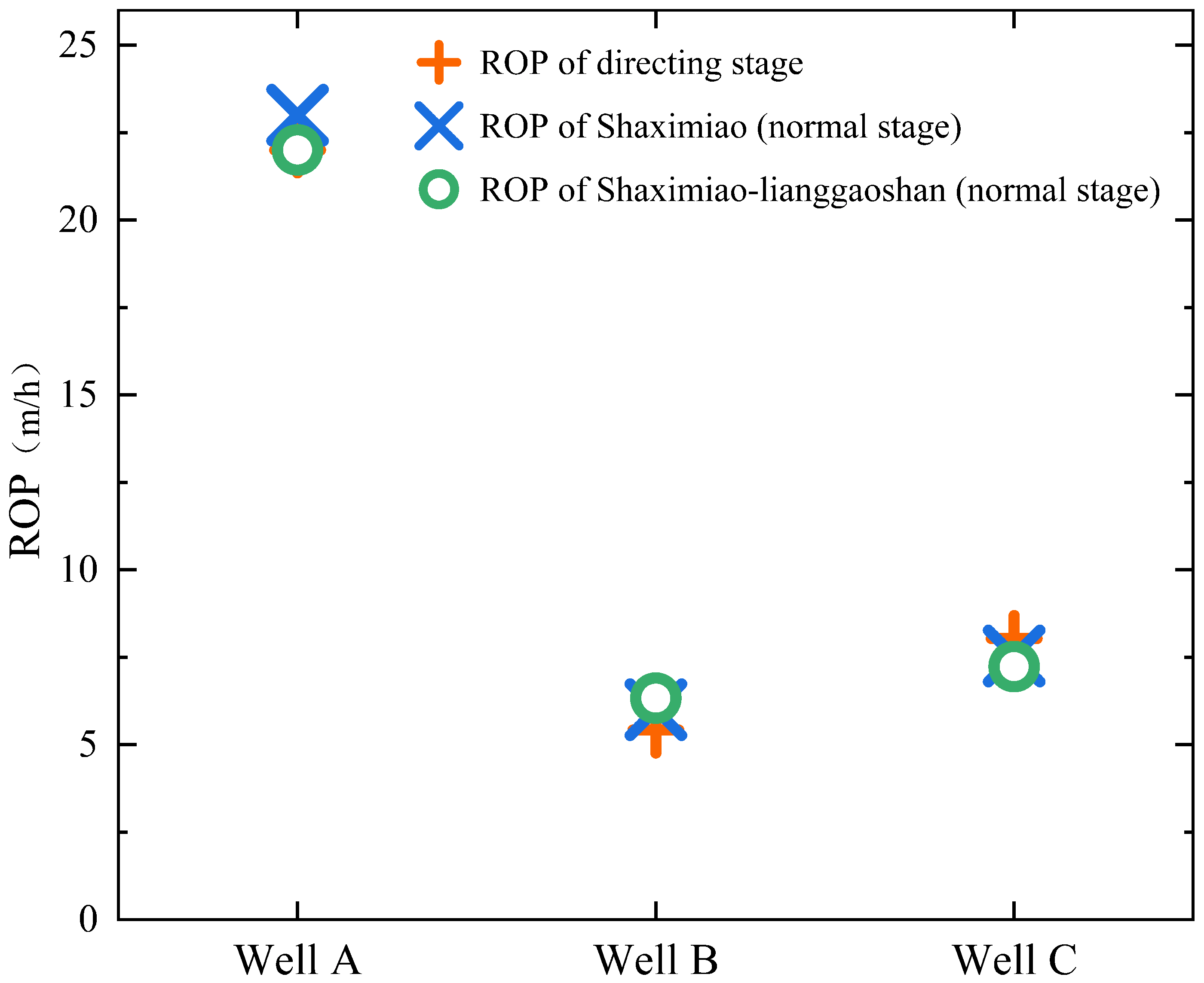
| Term | Value | Unit |
|---|---|---|
| Density | 2.62 | g/cm |
| Elasticity Modulus | 61.00 | GPa |
| Poisson’s ratio | 0.29 | |
| Yield Stress | 173.00 | MPa |
| Peak Cohesion | 39.00 | MPa |
| Peak Internal Friction Angle | 48.00 | ° |
| Peak Tensile Strength | 8.30 | MPa |
| Residual Cohesion | 7.80 | MPa |
| Residual Angle of Internal Friction | 9.60 | ° |
| Residual Tensile Strength | 1.66 | MPa |
| Term | Value | Unit |
|---|---|---|
| Angular speed | 5.0 | rad/s |
| back-rake angle | 15.0 | ° |
| Front cutter cutting depth | 2.0 | mm |
| back cutter cutting depth | 0.2–1.0 | mm |
| Confining Pressure | 73.4 | MPa |
| Fluid Pressure | 46.3 | MPa |
| Offset Coefficient | Range | ||
|---|---|---|---|
| Lower Value | Middle Value | Higher Value | |
| Vertical offset | 0.2 | 0.3 | 0.6 |
| Horizontal offset | −1 | 0 | 1 |
| Std | Run | Vertical Offset Coefficient | Horizontal Offset Coefficient | Combined MSE |
|---|---|---|---|---|
| 1 | 1 | 0.1 | −0.5 | 65.88183 |
| 3 | 2 | 0.1 | 0.0 | 62.84300 |
| 7 | 3 | 0.1 | 0.5 | 50.17540 |
| 2 | 4 | 0.3 | 0.0 | 62.47365 |
| 8 | 5 | 0.3 | 0.0 | 62.47365 |
| 11 | 6 | 0.3 | 0.0 | 62.47365 |
| 5 | 7 | 0.3 | 0.5 | 48.67719 |
| 9 | 8 | 0.3 | −0.5 | 60.03740 |
| 4 | 9 | 0.5 | −0.5 | 61.55718 |
| 6 | 10 | 0.5 | 0.0 | 63.13734 |
| 10 | 11 | 0.5 | 0.5 | 48.92523 |
| Source | Sum of Squares | df | Mean Square | F-Value | p-Value |
|---|---|---|---|---|---|
| Model | 401.2300 | 5 | 80.2500 | 51.74 | 0.0003 |
| A-A | 4.6500 | 1 | 4.6500 | 3.00 | 0.1440 |
| B-B | 262.6600 | 1 | 262.6600 | 169.36 | <0.0001 |
| AB | 2.3600 | 1 | 2.3600 | 1.52 | 0.2719 |
| A | 5.2800 | 1 | 5.2800 | 3.40 | 0.1244 |
| B | 130.9400 | 1 | 130.9400 | 84.43 | 0.0003 |
| Residual | 7.7500 | 5 | 1.5500 | ||
| Lack of Fit | 7.7500 | 3 | 2.5800 | ||
| Pure Error | 0.0000 | 2 | 0.0000 | ||
| Cor Total | 408.9800 | 10 |
| Offset Coefficient | Sum of Squares |
|---|---|
| Vertical offset | 0.641 |
| Horizontal offset | 0.497 |
Disclaimer/Publisher’s Note: The statements, opinions and data contained in all publications are solely those of the individual author(s) and contributor(s) and not of MDPI and/or the editor(s). MDPI and/or the editor(s) disclaim responsibility for any injury to people or property resulting from any ideas, methods, instructions or products referred to in the content. |
© 2024 by the authors. Licensee MDPI, Basel, Switzerland. This article is an open access article distributed under the terms and conditions of the Creative Commons Attribution (CC BY) license (https://creativecommons.org/licenses/by/4.0/).
Share and Cite
Huang, J.; Li, J.; Xie, Q.; He, Y.; Qian, L. Numerical Investigations for Rock-Breaking Process and Cutter Layout Optimization of a PDC Drill Bit with Dual-Cutter. Buildings 2024, 14, 129. https://doi.org/10.3390/buildings14010129
Huang J, Li J, Xie Q, He Y, Qian L. Numerical Investigations for Rock-Breaking Process and Cutter Layout Optimization of a PDC Drill Bit with Dual-Cutter. Buildings. 2024; 14(1):129. https://doi.org/10.3390/buildings14010129
Chicago/Turabian StyleHuang, Jian, Junxiong Li, Qiang Xie, Yuhang He, and Liqin Qian. 2024. "Numerical Investigations for Rock-Breaking Process and Cutter Layout Optimization of a PDC Drill Bit with Dual-Cutter" Buildings 14, no. 1: 129. https://doi.org/10.3390/buildings14010129
APA StyleHuang, J., Li, J., Xie, Q., He, Y., & Qian, L. (2024). Numerical Investigations for Rock-Breaking Process and Cutter Layout Optimization of a PDC Drill Bit with Dual-Cutter. Buildings, 14(1), 129. https://doi.org/10.3390/buildings14010129







